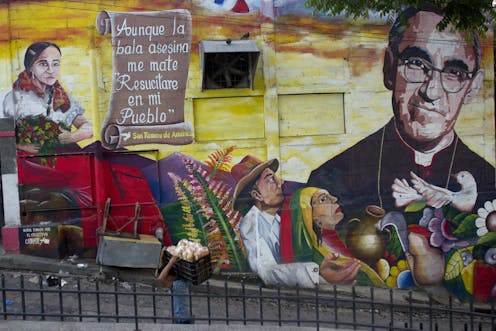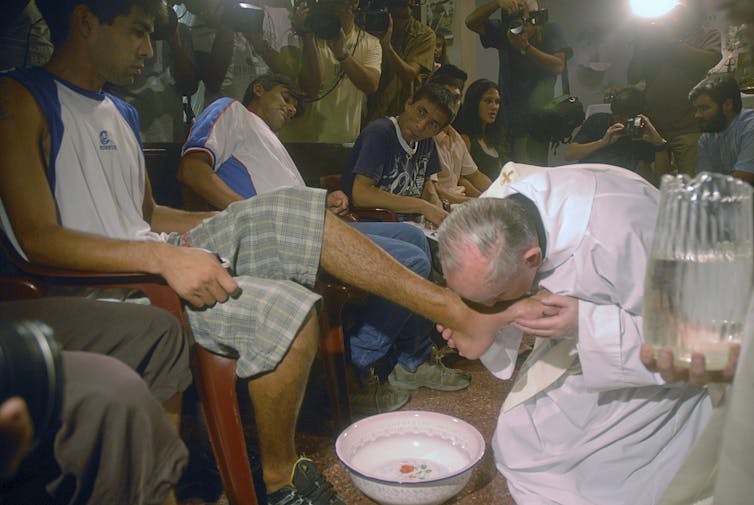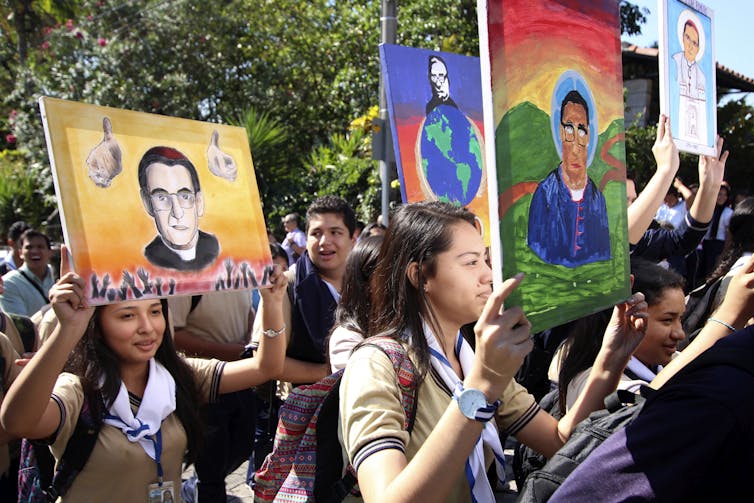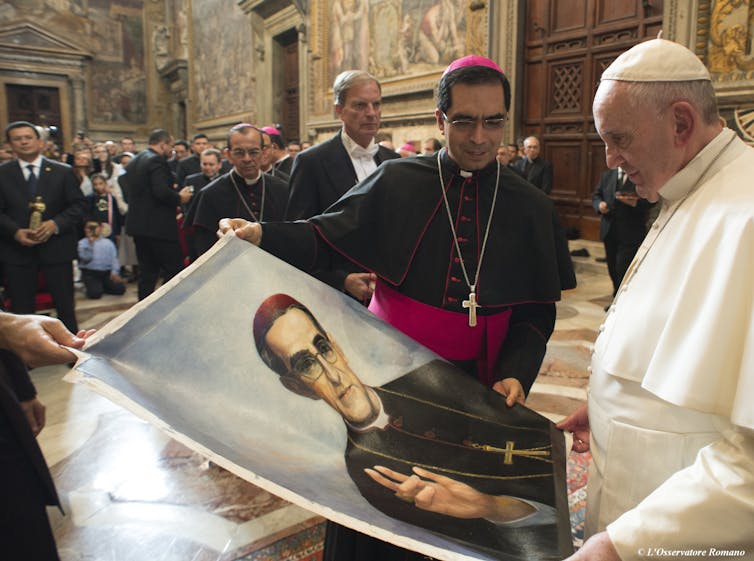Pope Francis drew inspiration from Latin American church and its martyrs – leaving a legacy for Pope Leo
- Written by Elizabeth O’Donnell Gandolfo, Associate Professor of Catholic and Latin American Studies, School of Divinity, Wake Forest University
 A mural of Roman Catholic Archbishop Oscar Romero decorates a wall in Panchimalco, El Salvador, May 21, 2015. AP Photo/Salvador Melendez
A mural of Roman Catholic Archbishop Oscar Romero decorates a wall in Panchimalco, El Salvador, May 21, 2015. AP Photo/Salvador MelendezPope Leo XIV’s election marks a historic moment: the first pope from an English-speaking country, and the first from the United States. Even more significant than these “firsts,” I believe, is a “second”: Leo follows in Pope Francis’ footsteps as a priest shaped by the Latin American church.
The new pontiff served the church in Peru throughout the late 1980s and ‘90s. Francis called him back to serve from 2015-2023 as bishop of the northern city of Chiclayo – where Catholics today are rejoicing over the election of one of their own, “un papa Chiclayano.”
As a Catholic theologian, I believe the College of Cardinals’ decision to elect another pontiff with such strong ties to Latin America reaffirms the continent’s influence on the global church’s sense of mission: to be a church that defends the marginalized and stands in solidarity with the oppressed.
This vision is embodied by the continent’s many Catholics who have given their lives for speaking out against repression, violence and poverty over the past 50 years – most famously St. Oscar Romero, whom Francis beatified in May 2015.
Having studied Latin American martyrdom closely, I would argue that Francis’ pontificate was at least partially inspired by these martyrs’ example, forged in blood. His decision to officially recognize this form of martyrdom adds to the legacy that many Latin American Catholics are hoping Leo will continue.
‘Church of the poor’
The Second Vatican Council, a series of meetings of bishops from around the world that took place between 1962-65, brought about a number of reforms in the Catholic church, including greater focus on the poor and vulnerable. During the council, a group of bishops gathered in the Catacombs of Saint Domitilla to sign a pact in which they committed themselves to renouncing wealth and privilege and becoming a “church of the poor.”
Many of these bishops were from Latin America, and in 1968, the Latin American Bishops’ Conference met to implement the council’s reforms. The documents that emerged from this meeting in Medellín, Colombia, encouraged closeness to people living in poverty and placed the promotion of justice and peace at the heart of the church’s evangelizing mission. In particular, they emphasized the church’s call to help liberate the oppressed from unjust social structures that produce poverty and violence.
 Pope Francis, then a cardinal, kisses a man’s foot during a Mass with youth trying to overcome drug addictions in Buenos Aires, Argentina, in 2008.AP Photo
Pope Francis, then a cardinal, kisses a man’s foot during a Mass with youth trying to overcome drug addictions in Buenos Aires, Argentina, in 2008.AP PhotoNot all Latin American bishops embraced this vision of the church’s mission. But many took the call to solidarity very seriously, denouncing economic injustices and human rights violations. These bishops and other socially committed Christians promoted causes like land reform, agricultural cooperatives, workers’ rights and access to health care and education.
At the time, many Latin American countries were marked by vast inequalities, military dictatorships and violent political repression. These regimes, many of which were backed by the United States, often labeled any opposition as “communist” and a threat to national security.
Some Latin American bishops – along with many priests, nuns and laypeople – paid for their faith-inspired commitments to justice and peace with their lives. Thousands of Christians were assassinated during the late 20th century because they stood up for the rights of the poor, or they spoke out against oligarchs for hoarding wealth, land and power. Others were targeted after denouncing military regimes for massacring, torturing and “disappearing” civilians.
Within some sectors of Latin American Catholicism, these women and men are rememberedas “martyrs”: people who, like Jesus of Nazareth, gave their lives for following what they saw as God’s mandate to speak the truth and practice compassion, justice and peace.
Pope’s recognition
During Francis’ pontificate, he officially recognized several of these Christians as martyrs, moving their cause for sainthood toward beatification and canonization. Beatification officially declares a person to be “blessed” and allows them to be venerated locally, while canonization makes them a full saint for the global church.
 Students hold up art depicting slain Salvadoran Archbishop Oscar Romero as they walk to the chapel in San Salvador where he was shot and killed.AP Photo/Salvador Melendez
Students hold up art depicting slain Salvadoran Archbishop Oscar Romero as they walk to the chapel in San Salvador where he was shot and killed.AP Photo/Salvador MelendezFor example, Bishop Enrique Ángel Angelelli was assassinated in 1976 for his solidarity with the poor and defense of workers’ rights during Argentina’s Dirty War – a violent campaign of state terrorism against critics of the military junta. Francis declared him a martyr in 2018. The following year, Angelelli was beatified, along with two priests and a lay leader from the same province who were all similarly martyred just weeks before.
Archbishop Óscar Arnulfo Romero was equally committed to defending the poor of El Salvador during the years of armed conflict leading up to the Salvadoran Civil War. In his Sunday homilies, he named people who had been imprisoned, tortured and disappeared by military and paramilitary forces, and drew on the Gospel and church teaching to challenge the violence and oppression of the day.
His promotion of human rights and his demand that the military “stop the repression” led to his assassination while celebrating Mass on March 24, 1980. Francis declared Romero a martyr and beatified him in 2015, then canonized him in 2018.
 Pope Francis views an image of Roman Catholic Archbishop Oscar Romero during a private audience at the Vatican in 2015.L'Osservatore Romano/Pool Photo via AP
Pope Francis views an image of Roman Catholic Archbishop Oscar Romero during a private audience at the Vatican in 2015.L'Osservatore Romano/Pool Photo via APThese actions placed a stamp of approval on how leaders like Angelelli and Romero embodied the church’s mission in their own time and place. But Francis’ recognition also made a broader statement about how the church should relate to the “powers and principalities” of the world. Throughout his papacy, Francis continued these martyrs’ commitment by standing with people on the “peripheries”: washing the feet of prisoners, defending the rights of migrants and demanding care for the Earth.
Martyrs of the Earth
In the 21st century, care for the Earth is producing a whole new generation of martyrs like Angelelli and Romero. Land and environmental defenders in Latin America and around the world are being assassinated for their work to mitigate harm from industries like fossil fuel extraction, mining, logging, ranching and more.
In September 2024, Francis signaled his awareness of this phenomenon when he lamented the murder of Juan Antonio López. López was a lay Catholic leader in Honduras whose faith inspired him to defend local communities, lands and rivers from open-pit iron oxide mining.
The Latin American bishops’ conference has taken note of this resurgence in violent persecution. In December 2024, it launched a campaign called “Life is hanging on by a thread,” promoting solidarity with the work of ecological and human rights defenders like López.
As a former vice president of the Peruvian bishops’ conference, Pope Leo XIV is likely aware of this campaign and the violence that it hopes to disarm.
The new pope had a close relationship with Francis, whose legacy looms large. A key inspiration for that legacy, however, is the witness of Latin American Christians whose blood has been shed for justice, peace and the environment.
Only time will tell if this new pontiff’s leadership continues their indomitable solidarity with people whom, in Francis’ words, this world has deemed to be “disposable.”
Elizabeth O’Donnell Gandolfo does not work for, consult, own shares in or receive funding from any company or organization that would benefit from this article, and has disclosed no relevant affiliations beyond their academic appointment.
Authors: Elizabeth O’Donnell Gandolfo, Associate Professor of Catholic and Latin American Studies, School of Divinity, Wake Forest University

